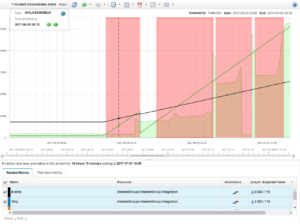Predictive Insights, AI originated from Watson
Compose IT has in earlier articles mentioned Predictive Insights (PI) from IBM and it is time to tell about our experiences so far.
Initially, we wanted to find out what value PI could bring to our customers and their IT environments and to do this we set up PI in our own lab and started testing with production data. In parallel, we also got the fantastic opportunity to visit IBM in Cork in Ireland where we met the people who developed PI.
PI originally came from Watson, IBM’s Artificial Intelligence Research Program (AI). The goal is to use AI to extract value from indicator values. PI can load time series of indicators from several different types of sources and uses that number of selected algorithms from Watson to analyze the input. The algorithms work together and independently to create dynamic patterns that describe the normal behavior of the time series. The patterns are created in real time and adapted as the behavior of the indicators changes. By constantly continuing to learn the normal behavior of the indicators, it becomes possible to get value that cannot be extracted with static limit values. Since PI knows what is normal for all times, it can alert as soon as a deviation occurs and thus eliminates the risk of detecting an error late or getting false alarms.
Knowing the normal behavior of each indicator also makes it possible to find relationships between indicators. PI finds relationships by finding the indicators that have repeatedly influenced each other, for example. indicator value 1 increases while indicator value 2 decreases. The ability to find relationships makes it possible to reduce the number of alarms when the related alarms are merged into one. It also facilitates troubleshooting when all affected parties are known.
PI’s knowledge of the indicators’ normal behavior combined with its ability to find relationships enables it to live up to its name and actually predict the future. It can predict how an indicator will probably behave within the next 6-12 intervals. It can also predict if a deviating indicator can cause deviation of another indicator. In summary, PI gives you the opportunity to act before a problem actually becomes a problem. Predictive Insight gives you the opportunity to be proactive rather than reactive.
Products that PI offers, properly used, a great value. To create this value, one must be aware of the challenges that come with using machine learning and AI.
Data is the basis of AI because everything it knows is based on the information it receives. Therefore, it is also data and, above all, the quality of data that poses the greatest challenges. It is important to give AI data of good quality that reflects reality. If you give the wrong, corrupt or partial information, it affects the result because AI learns the patterns based on the information over time. The longer it is trained on incorrect information, the greater the effect it will have on the result. The quality of the result is not better than the data quality it is based on. Good data quality is the most important component for a good result with it not the end. The information given to the AI machine can be perfect and still give a poor result if the information is not properly analyzed. The algorithms must be properly applied because some algorithms are made for a particular type of data while others have a general application. It can be difficult to know how the algorithms should be applied since some algorithms work together and others work independently. PI solves this better than the competition and makes the decision for us by automatically knowing which algorithms to apply. This makes the configuration of PI simple and easy while giving you more time to focus on what is important.
Now you probably wonder how it went with the lab we set up, did we find something interesting? The short answer is YES. We ran both CSV files with historical data and streamed JSON objects with real-time data in the lab. The CSV files and the JSON objects contained two different types of cases. In one case, we thought that PI would be the right solution, but proved difficult to apply. In the second case, PI was valuable and found potential problems.
More information about our experiences and how our work with PI progresses here so keep your eyes open!
